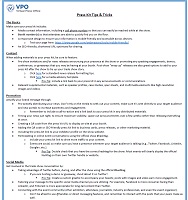
Originally posted on PR Newswire’s Beyond PR blog: http://www.prnewswire.com/blog/how-to-know-whether-your-product-launch-is-trade-show-ready-19859.html
Launching a product at a trade show can be a great way to focus on your event marketing strategy and spotlight a new product in front of a targeted audience. There are times, however, when launching a product at an event can put your company at risk of losing potential clients and damaging your brand’s reputation.
At Macworld in 2007, Apple unveiled the first generation of a revolutionary product: the iPhone. But did you know that while Steve Jobs was conducting the demonstration, Apple employees behind the scenes weren’t sure it was going to work?
Luckily, everything worked out for Apple, but it’s not recommended to put your company in that risky of a situation.
Avoid the tension by asking these four questions before unveiling a product at your next trade show.
Will the product be ready for show time?
First impressions are everything. If your product is “glitchy” or not working at 100 percent it can be a big turn off for attendees and prospects.
Before focusing all of your pre-show marketing on a new product launch, work backwards and triple check your new product will be fully functioning for the show. The product should probably be in beta a few months before the show in order for testers and tech teams to work out any kinks.
If the deadlines are cutting it too close, consider taking a different approach to your trade show strategy. Preparing for an event is hectic enough as it is — you don’t want to be put in the position of scrambling to change all of your event collateral last minute.
Will the product be available to demo at the show?
Your product may be ready for launch but if a prototype or master version won’t be available for demos at the event, you might be setting prospects up for disappointment.
Ensure you will have the product available and the resources at hand to successfully demo the product at the event (transportation, electricity, Internet, enough booth space, etc.). If your product is Internet- based, consider having a hotspot at your booth since Wi-Fi can be spotty at event venues.
Some software and services companies may be able to get away with not having the product to demo if booth staffers can talk in detail about the new product’s features. Consumer companies, however, should think hard before unveiling a new product with nothing to sample.
For instance, Jelly Belly announced they would unveil a new beer-flavored jelly bean at the Winter Fancy Food Show in 2014. If they came to the show with no beer-flavored beans to try, there would have been disappointment all around.
Before centering your strategy around a product you won’t actually have at a show, consider whether prospects would be ok with no demo, or if they would walk away in frustration.
Is another company unveiling something bigger, or similar to my product?
Nothing is worse than having the biggest announcement in your company’s history and seeing it overshadowed by a competing brand. Do your research and make sure the bigger players in the market aren’t unveiling anything revolutionary.
To accomplish this, check the exhibitor list often to look for competitors. Then, monitor their newsrooms or online press kits for news about any potential product unveilings at the show that could take attention away from your product.
Pro-tip: Some trade shows offer a press room that aggregates event content from other exhibitors. If the event offers an online press room, monitor the page or sign up for news alerts to receive emails each time a new release is posted to ensure you’re not missing any important news.
Can I offer a beta test version to attendees?
Sometimes it’s not realistic that a product will be 100 percent ready for a trade show; this doesn’t necessarily mean you should refocus your trade show objective.
As long as the product doesn’t have too many technical issues, offering prospects a beta version is a great way to get valuable feedback before it goes public. Prospects get to try the product for free (and hopefully get hooked) and you get suggestions for improvement. It’s a win–win situation.
Pro-tip: Get even more benefits by offering prospects the chance to try a beta version in exchange for their contact information. These prospects can then be added to email lists or marketing automation platforms for future content marketing initiatives.
Unveiling a new product and exhibiting at a trade show can be a company’s two biggest milestones in a calendar year – the urge to combine them into one mega event is logical.
Sometimes taking risks pays off, but other times, risks can cost time, money and clients. Before you decide to launch a product at an event, make sure your product and brand shine in the brightest light.
Discover what else is needed for product launch success by downloading Expanding Engagement & Inspiring Action with Your Next Product Launch. This free checklist will walk you step by step through your new product’s marketing strategy.
Author Caterina Lui is a senior customer content specialist for Virtual Press Office, PR Newswire’s trade show marketing solutions division. VPO helps global event professionals, exhibitors and trade show marketing managers reach their goals through news distribution and online press kit creation. Follow Caterina at @VPOEventZone, our Twitter channel dedicated to the trade show industry.



